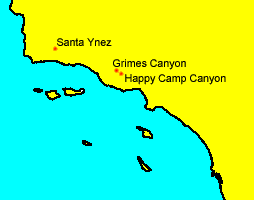Fused Shale
Fused shale is a glassy rock, similar in appearance to obsidian, formed by the natural combustion of sedimentary rock that is rich in organic material. At least three sources of the material are known in southern California: Grimes Canyon and Happy Camp Canyon, both in Ventura County, and the Santa Ynez Valley in Santa Barbara County.
 Richard E. Hughes and Polly A. Peterson (2009) have documented possible confusion, both on the basis of macroscopic inspection and chemical analysis, between archaeological specimens made from fused shale and ones produced from obsidian coming from the Obsidian Butte source.
Richard E. Hughes and Polly A. Peterson (2009) have documented possible confusion, both on the basis of macroscopic inspection and chemical analysis, between archaeological specimens made from fused shale and ones produced from obsidian coming from the Obsidian Butte source.
In the vicinity of its natural occurrence, fused shale was used extensively, particularly for making projectile points, bifaces, and drills. The area within which fused shale artifacts have been recovered extends, at least, from Santa Barbara to southern Orange County (Chartkoff 1989; Demcak 1981). The heaviest use of the material seems to have been during the period after A.D. 500. However, there is evidence for use as early as 8000 B.C. (Demcak 1981; Singer 1986).
A few possible occurrences of fused shale in San Diego County sites have been reported:
- Five pieces of chipping waste from site SDM-W-1556 in San Marcos were identified by Clay Singer as being fused shale (O’Neil 1982:154). The main component at the site was assigned to the Late Prehistoric period, but an Archaic-period (Campbell tradition) component was also identified.
- Georgie Waugh (1986:211) reported recovering one fragment of a fused shale bead from site SDI-731, a Late Prehistoric habitation area on Frey Creek near the upper San Luis Rey River.
- An archaeological specimen of glassy material from site SDI-4648 near El Cajon was analyzed by Paul Bouey, using x-ray fluorescence. Bouey concluded that the trace element characteristics of the specimen did not match those for any of the familiar obsidian sources and that “this may be because the piece is fused shale, or it may come from an unknown obsidian source” (Cardenas and Van Wormer 1984).
PROSPECTS
Future investigations may be able to confirm the presence of fused shale in archaeological assemblages in San Diego County and define its spatial distribution within the county, its temporal presence during different time periods, and its uses. The specific geologic sources of the material may also be identified.